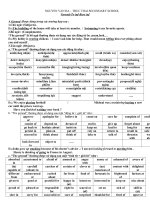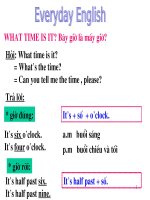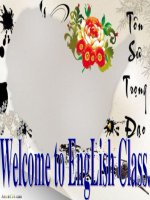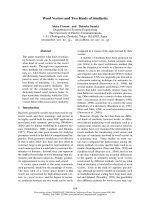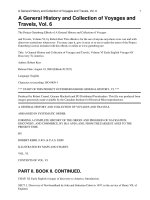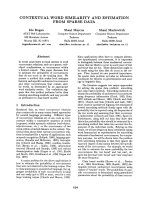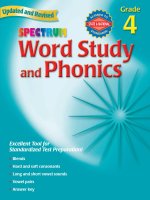Word Study and Phonics, Grade 6 (Spectrum) ppt
Bạn đang xem bản rút gọn của tài liệu. Xem và tải ngay bản đầy đủ của tài liệu tại đây (2.26 MB, 171 trang )
WORD STUDY AND PHONICS
Grade 5
Visit our Web site at:
www.FrankSchaffer.com
EAN
ISBN 0-7696-8295-2
UPC
U.S. $9.95
Can. $12.95
Making Children More Successful!
Spectrum, our best-selling workbook series, is proud to provide quality educational
materials that meet students’ needs for learning achievement and success.
Spectrum Word Study and Phonics Grade 5 helps young learners improve and
strengthen their phonics skills, such as:
• Digraphs • Homophones
• Diphthongs • Idioms
• Syllables • Dictionary skills
Excellent Tool for
Standardized Test Preparation!
•
Digraphs
•
Diphthongs
•
Syllables
•
Homophones
•
Idioms
•
Dictionary skills
•
Answer key
Reading (Grades K–6)
Math (Grades K–8)
Spelling (Grades 1–6)
Writing (Grades 1–8)
Language Arts (Grades 2–6)
V
ocabulary (Grades 3–6)
T
est Prep (Grades 1–8)
Test Practice (Grades 1—8)
Geography (Grades 3–6)
Phonic
s (Grades K–3)
Word Study and Phonics (Grades 4–6)
Science Test Prep (Grades 3–8)
Basic Concepts and Skills (Preschool)
L
earning Letters (Preschool)
Math Readiness (Preschool)
Word Study and
Phonics
Grade 5
Published by
Frank Schaffer Publications
®
Spectrum is an imprint of Frank Schaf
fer Publications.
Printed in the United States of America. All rights reserved. Except as permitted under the United States Copyright Act, no
part of this publication may be reproduced or distributed in any form or by any means, or stored in a database or retrieval
system, without prior written permission from the publisher, unless otherwise indicated. Frank Schaffer Publications is an
imprint of School Specialty Publishing. Copyright © 2007 School Specialty Publishing.
Send all inquiries to:
Frank Schaf
fer Publications
8
720 Orion Place
Columbus, Ohio 43240-2111
Spectrum Word Study and Phonics—grade 5
ISBN 0-7696-8295-2
1 2 3 4 5 6 POH 1
1 10 09 08 07 06
Frank Schaffer Publications
®
3
Lesson 1.2 Table of Contents Grade 5
Chapter 1 Phonics
Lesson 1.1 Hard and Soft c and g. . . . . . . . . . . . . . . . 6
Lesson 1.2 The Sounds of
s . . . . . . . . . . . . . . . . . . . . . 10
Review: Hard and Soft
c and g and
the Sounds of
s . . . . . . . . . . . . . . . . . . . . . . . . . . . . . 12
Lesson 1.3 Consonant Digraphs . . . . . . . . . . . . . . . . 14
Lesson 1.4 More Consonant Digraphs . . . . . . . . . . . 16
Lesson 1.5 Silent Consonants . . . . . . . . . . . . . . . . . . . 18
Lesson 1.6 More Silent Consonants . . . . . . . . . . . . . . 20
Lesson 1.7 The Sound of
Ti and Ci . . . . . . . . . . . . . . . 22
Review: Digraphs, Silent Consonants,
Ti and Ci . . . . 24
Lesson 1.8 Vowel Sounds (
ai, ay, ei, ey) . . . . . . . . . . 26
Lesson 1.9 Vowel Sounds (
ee, ea, ie, ey). . . . . . . . . . 28
Lesson 1.10 Vowel Sounds (
ind, ild, igh) . . . . . . . . . . 30
Lesson 1.11 Vowel Sounds (
oa, ow, old, oll, ost) . . . . 32
Review: Vowel Sounds. . . . . . . . . . . . . . . . . . . . . . . . . 34
Lesson 1.12 Vowel Sounds (
oo, ew, ou, ui) . . . . . . . . 36
Lesson 1.13 Vowel Sounds (
au, aw, al, all) . . . . . . . . 38
Lesson 1.14 Vowel Diphthongs . . . . . . . . . . . . . . . . . . 40
Review: Vowel Sounds and Diphthongs . . . . . . . . . . 42
Lesson 1.15 The Schwa Sound . . . . . . . . . . . . . . . . . . 44
Lesson 1.16 The Sounds of
y . . . . . . . . . . . . . . . . . . . . 48
Lesson 1.17
R-Controlled Vowels (ar, er, ir, or, ur) . . . 50
Lesson 1.18 More
r-Controlled Vowels
(
air, are, ear, eer) . . . . . . . . . . . . . . . . . . . . . . . . . . . . 52
Review: Schwa, the Sounds of
y, and
r-Controlled Vowels . . . . . . . . . . . . . . . . . . . . . . . . . . 54
Spectrum Word Study and Phonics
Grade 5 Table of Contents
Table of Contents, continued
Chapter 2 Word Structure
Lesson 2.1 Base Words and Inflectional Endings . . . 56
Lesson 2.2 Comparative Endings. . . . . . . . . . . . . . . . 58
Review: Base Words, Inflectional Endings,
and Comparative Endings. . . . . . . . . . . . . . . . . . . . 60
Lesson 2.3 Plurals . . . . . . . . . . . . . . . . . . . . . . . . . . . . . 62
Lesson 2.4 Irregular Plurals . . . . . . . . . . . . . . . . . . . . . 64
Lesson 2.5 Possessives . . . . . . . . . . . . . . . . . . . . . . . . . 66
Review: Plurals, Irregular Plurals, and Possessives . . . 68
Lesson 2.6 Compound Words . . . . . . . . . . . . . . . . . . 70
Lesson 2.7 Contractions . . . . . . . . . . . . . . . . . . . . . . . 72
Review: Compound Words and Contractions. . . . . 74
Lesson 2.8 Prefixes . . . . . . . . . . . . . . . . . . . . . . . . . . . . 76
Lesson 2.9 Suffixes . . . . . . . . . . . . . . . . . . . . . . . . . . . . 82
Review: Prefixes and Suffixes . . . . . . . . . . . . . . . . . . . 88
Lesson 2.10 Syllables . . . . . . . . . . . . . . . . . . . . . . . . . . 90
Review: Syllables . . . . . . . . . . . . . . . . . . . . . . . . . . . . . 92
Chapter 3 Vocabulary
Lesson 3.1 Synonyms and Antonyms. . . . . . . . . . . . . 94
Lesson 3.2 Shades of Meaning . . . . . . . . . . . . . . . . . 98
Lesson 3.3 Levels of Specificity. . . . . . . . . . . . . . . . . 100
Review: Synonyms, Antonyms, Shades
of Meaning, and Levels of Specificity. . . . . . . . . . 102
Lesson 3.4 Homophones. . . . . . . . . . . . . . . . . . . . . . 104
Lesson 3.5 Multiple-Meaning Words . . . . . . . . . . . . 106
4
Spectrum Word Study and Phonics
Grade 5 Table of Contents
5
Spectrum Word Study and Phonics
Grade 5 Table of Contents
Review: Homophones and
Multiple-Meaning Words. . . . . . . . . . . . . . . . . . . . . 108
Lesson 3.6 Clipped Words, Acronyms,
and Initializations . . . . . . . . . . . . . . . . . . . . . . . . . . . 110
Lesson 3.7 Word Play. . . . . . . . . . . . . . . . . . . . . . . . . 112
Review: Clipped Words, Acronyms,
and Word Play . . . . . . . . . . . . . . . . . . . . . . . . . . . . . 114
Lesson 3.8 Figures of Speech . . . . . . . . . . . . . . . . . . 116
Lesson 3.9 Idioms . . . . . . . . . . . . . . . . . . . . . . . . . . . . 120
Lesson 3.10 Analogies . . . . . . . . . . . . . . . . . . . . . . . . 122
Review: Figures of Speech, Idioms,
and Analogies . . . . . . . . . . . . . . . . . . . . . . . . . . . . . 126
Chapter 4 Dictionary Skills and Word Origins
Lesson 4.1 Guide Words . . . . . . . . . . . . . . . . . . . . . . 128
Lesson 4.2 Entry Words . . . . . . . . . . . . . . . . . . . . . . . 130
Review: Guide Words and Entry Words . . . . . . . . . 132
Lesson 4.3 Word Families. . . . . . . . . . . . . . . . . . . . . . 134
Lesson 4.4 Word Origins . . . . . . . . . . . . . . . . . . . . . . 138
Review: Word Families and Word Origins . . . . . . . . 142
Lesson 4.5 Pronunciation Key and Respellings. . . . 144
Lesson 4.6 Accent Marks . . . . . . . . . . . . . . . . . . . . . 148
Review: Respellings and Accent Marks . . . . . . . . . 150
Table of Contents, continued
NAME
Lesson 1.1 Hard and Soft c and g
Spectrum Word Study and Phonics Chapter 1 Lesson 1
Grade 5 Phonics
6
Read the clues below. Choose the word from the box that matches each clue. Make
sure that the word has the correct hard or soft
c or g sound.
1. a desert plant that can live on very little water (hard c) ____________________
2. to look at something steadily (hard g) ____________________
3. to complain (hard g) ____________________
4. the study of Earth’s history and structure (soft g) ____________________
5. a member of the royal family (soft c) ____________________
6. the name of a citrus fruit, as well as a color (soft g) ____________________
7. a solid shape that has six sides of the same size (hard c) ____________________
8. dangerous or savage (soft c) ____________________
Read the words in each line below. Circle the word that has the same hard or soft
c or
g sound as the word in bold.
1. police picnic include juice golden
2. engine Georgia wagon struggle nighttime
3. forgotten college legend cage goose
4. popcorn decide candle peace cheerful
5. village gymnastics grounded celery global
6. gravity weight fragile energy glitter
7. copper principal cartwheel cereal slice
• The letter c can make a hard sound, as in corner and welcome. When c is
followed by
e, i, or y, it can make a soft sound, as in cider, celery, and cycle.
• The letter
g can make a hard sound, as in ground and began. When g is
followed by
e, i, or y, it can make a soft sound, as in gerbil, fragile, or stingy.
cactus cube gaze orange prince geology grumble fierce
NAME
Spectrum Word Study and Phonics Chapter 1 Lesson 1
Grade 5 Phonics
Read the paragraphs below. Look for words with the hard and soft c and g sounds.
Then, write the words in the correct columns. You do not need to list the same word
more than once. Hint: Two words can be listed in more than one column.
The tea ceremony is an age-old ritual that has an important place in traditional
Japanese society. The person who prepares and serves the tea is called a practitioner.
Some ceremonies may last as long as four hours and include food, while other
ceremonies are much shorter.
A tea practitioner may study the art of the tea ceremony for an entire lifetime. A
practitioner must know the different types of tea and how they are produced. He or
she must also know about other elements of Japanese culture, like kimonos, incense,
and flower arranging. Even guests at a tea ceremony need to know about tea and the
proper manners and gestures to use.
Certain equipment is needed for even a basic ceremony. For example, a
rectangular white cloth is used to clean the tea bowl. A ladle, called
hishaku, is used for
removing tea from the pot. The tea bowls are among the most important parts of the
ceremony. On some occasions, fragile bowls that are hundreds of years old may be
used. Even an irregular bowl can be valuable. Its imperfections show that it was
handmade.
7
Lesson 1.1 Hard and Soft c and g
Hard c
____________________
____________________
____________________
____________________
____________________
____________________
____________________
____________________
____________________
____________________
____________________
Soft
c
____________________
____________________
____________________
____________________
____________________
____________________
Har
d g
____________________
____________________
____________________
____________________
Soft
g
____________________
____________________
____________________
____________________
NAME
Lesson 1.1 Hard and Soft c and g
Spectrum Word Study and Phonics Chapter 1 Lesson 1
Grade 5 Phonics
Read the paragraphs below. Listen carefully to the c or g sound in each word in bold.
On the line beside it, write hard
c, hard g, soft c, or soft g.
The Jungle ____________________ Book has been a part of many children’s lives
since ____________________ it was first published in 1894. Its author, Rudyard Kipling
____________________, was the youngest ____________________ person ever to receive
____________________ the Nobel Prize for Literature. Although he wrote other books and
poems
during ____________________ his life, nothing ____________________ matched the
huge ____________________ success of The Jungle Book.
The book
consists ____________________ of several stories which were first printed in
magazines ____________________. The main character is a boy named Mowgli
____________________, who was raised by wolves in the jungles of India.
More than a hundred years have passed since the stories’
original ____________________
publication ____________________, but they are still enjoyed by kids all around the world.
Complete each sentence below with a word from the box. The word you choose
should make sense in the sentence and have the correct sound.
1. Rudyard Kipling was born in Bombay, India, which is ____________________ (hard c)
Mumbai today.
2. Kipling and his sister spent part of their childhood in ____________________ (hard g).
3. After Kipling finished school, he ____________________ (soft c) to work as a
newspaper editor in India.
4. Kipling ____________________ (hard g) the material for his book Just So Stories for
Little Children
during his ____________________ (hard c) travels.
8
African decided gathered called England
NAME
Spectrum Word Study and Phonics Chapter 1 Lesson 1
Grade 5 Phonics
On the line, write the word that names the picture. Then, write the words from the box
that have the same hard or soft
c or g sound under the correct headings.
9
Lesson 1.1 Hard and Soft c and g
oxygen Iceland gypsy coupon specific sugar computer griddle
_________________
_________________
_________________
_________________
_________________
_________________
_________________
_________________
_________________
_________________
_________________
_________________
Read the sentences below. On the line, write the word from the box that best completes
each sentence. If the word contains a hard
c or g sound, circle it. If it contains a soft c
or g sound, underline it.
1. Amelia spent the afternoon at her ____________________ house.
2. It was a cold and ____________________ day, but the house was warm and cozy.
3. Gr
anny Kay stirred a pot of ____________________ simmering broth.
4. “Gumbo is a hot and ____________________ Louisiana soup or stew,” said Granny Kay.
5. “White ____________________ is one of the most important ____________________ in
gumbo.”
6. “The secret is using the best shrimp, ____________________, and crawfish.”
7. “It’s also important to use plenty of fresh ____________________, like okra, tomatoes,
bell peppers, onions, and celery.”
8. Amelia tasted the gumbo from the wooden spoon.“Now I see why your recipe is
so ____________________ in our family!” exclaimed Amelia.
rice gloomy legendary crab grandmother’s
ingredients gently vegetables spicy
NAME
Lesson 1.2 The Sounds of s
Spectrum Word Study and Phonics Chapter 1 Lesson 2
Grade 5 Phonics
10
Read the sentences below. On the line, write the s sound (s, z, zh, or sh) you hear in
each word in bold. If the word contains more than one sound of
s, separate the sounds
with a slash. (Ex.: s/z)
1. The Smithsonian ______ Institution has 19 museums ______ and 7 research centers.
2. Most ______ of the buildings ______ are in Washington, D.C.
3. The Smithsonian owns ______ about 142 million items ______.
4. The Anacostia Museum is ______ a place where people can learn about African
American
traditions ______ and history ______.
5. The Smithsonian owns the spacesuit ______ Neil Armstrong ______ wore when he
walked on the moon in 1969.
6. Two giant pandas ______, named Mei Xiang and Tian Tian, are on loan to the
Smithsonian Zoo until 2010.
7. The National Gem and Mineral Collection includes ______ more than 375,000
specimens ______.
8. The Star of Asia ______ Sapphire ______ is one of the most famous in the collection
and makes quite an
impression ______.
9. Many people are interested in seeing treasures ______ like the Hope diamond—
the world’s
largest ______ deep blue diamond.
The letter s can make different sounds.
• It can make the /s/ sound, as in
stranger.
• It can make the /z/ sound, as in
busy.
• It can make the /sh/ sound, as in
sugar or pressure.
• It can make the /zh/ sound, as in
casual.
NAME
Spectrum Word Study and Phonics Chapter 1 Lesson 2
Grade 5 Phonics
Read each word in bold below. Say the words beside it out loud to yourself. Then, circle
the word that has the same sound of
s.
1. asleep measure locksmith music
2. poison Spanish usual cheese
3. casual pleasure spaghetti news
4. expansion somersault sure deserve
5. tension desert perhaps tissue
Complete each joke below with a word from the box. The word you choose should
make sense in the sentence and have the correct sound of
s.
1. Q: What has six legs, three ears, four tusks, and two trunks?
A: An elephant with ____________________ parts (/s/ sound).
2. Q: Where do frogs keep their ____________________ (/zh/ sound)?
A: In a croak of gold at the end of the rainbow.
3. Q: What gets wetter the more it ____________________ (/z/ sound)?
A: A towel.
4. Q: How do you stop a charging elephant?
A: Take away its credit ____________________ (/z/ sound).
5. Q: What is so fragile that even saying its name can break it?
A: ____________________ (/s/ sound).
6. Q: Why does history keep repeating itself?
A: Because we weren’t ____________________ (/s/ sound) the first time.
7. Q: What does the candyman use to help him walk?
A: A ____________________ (/sh/ sound).
11
Lesson 1.2 The Sounds of s
treasure spare sugarcane listening cards dries silence
NAME
Read the clues below. On the line, write the word from the box that matches the clue
and has the sound listed in parentheses. Then, find each word in the word search puzzle.
1. unique; the opposite of common (/zh/ sound) ____________________
2. a type of basement (soft c) ____________________
3. delicate; easily damaged (soft g) ____________________
4. protection against loss from fire or theft (/sh/ sound) ____________________
5. a southern state (soft g) ____________________
6. a political body that directs the affairs of a country (hard g) ____________________
7. a meal that is eaten outside (hard c) ____________________
8. to poke fun at (/z/ sound) ____________________
9. to be unable to speak, often because of surprise (/s/ sound) ____________________
10. the opposite of negative (/z/ sound) ____________________
12
Spectrum Word Study and Phonics Review: Lessons 1–2
Grade 5 Phonics
Review Hard and Soft c and g and the Sounds of s
REVIEW: CHAPTER 1 LESSONS 1–3
government speechless Georgia tease unusual
positive cellar insurance picnic fragile
n k e t y m m f t n g u a a e
m l o e r n p v c y s n q w c
j i f r a g i l e g t u c i o
l p s p e e c h l e s s v n a
q f t o b o n d l e x u h s p
t e a s e r i b a r v a f u i
n k f i r g c b r z e l g r y
j u w t p i g q w a p o g a t
n u r i t a n w e u u k l n d
h g o v e r n m e n t e r c v
j y b e d s r t k c l s n e p
NAME
Read the words in the box. Write each word under the correct heading below.
13
Spectrum Word Study and Phonics Review: Lessons 1–2
Grade 5 Phonics
Review Hard and Soft c and g and the Sounds of s
REVIEW: CHAPTER 1 LESSONS 1–3
clasped pleasant sure casual always decision springtime measure
costly misplace wisdom sugar rosy expansion leisure pressure
/s/ sound
_________________
_________________
_________________
_________________
/z/ sound
_________________
_________________
_________________
_________________
/zh/ sound
_________________
_________________
_________________
_________________
/sh/ sound
_________________
_________________
_________________
_________________
Circle the word in parentheses that best completes each sentence below. On the line,
write the sound of
c or g that appears in the word.
1. The word castle (originally, usually) came from a Latin
word meaning fortress. ____________________
2. Throughout history, castles have been used as protection
against enemies, as well as homes for their owners in
times of (place, peace). ____________________
3. Most castles included features that were intended
to (crowd, protect) the occupants. ____________________
4. For example, a moat was a (large, gentle), deep trench
filled with water that surrounded a castle. ____________________
5. Moats were difficult for enemies to cross, and they also
made it difficult for enemies to dig (underground,
grateful) tunnels to the castle. ____________________
6. A (legend, drawbridge) could help the owner of a castle
control who entered and exited the castle. ____________________
7. Castles built in enemy territory could be used to take over
the (amazing, surrounding) area. ____________________
NAME
Lesson 1.3 Consonant Digraphs
Spectrum Word Study and Phonics Chapter 1 Lesson 3
Grade 5 Phonics
14
Read the letter below. Underline the words that contain the digraphs sh or ch. Then,
write each underlined word below the correct heading. You do not need to list the
same word more than once.
A digraph is a blend of two consonants that form a new sound.
• The digraph
sh makes the /sh/ sound, as in shovel and smash.
• The digraph
ch can make the /ch/ sound, as in choose and lunch. It can also
make the /k/ sound, as in
chord, and the /sh/ sound, as in chef.
____________________
____________________
____________________
____________________
____________________
____________________
____________________
____________________
____________________
____________________
____________________
/ch/ sound
____________________
____________________
____________________
____________________
____________________
____________________
____________________
/k/ sound
____________________
____________________
____________________
____________________
____________________
/sh/ sound
Dear Shelby,
Are you having a good spring break? My visit to Chicago has been excellent so far.
Uncle Chris is a chef at a chic restaurant. He’s also a member of a choir. We ate at his
restaurant one night, and I chose a delicious shellfish dish. Aunt Charlotte is a chemist. She
spends most of her time doing research.
My cousin, Charley, is quite a character. If he lived closer, I have a hunch you two would
become friends in no time. He seemed shy at first, but he turned out to have such a great
sense of humor. Charley is a champion chess player. He also raises chameleons and has a
shaggy sheepdog named Harold.
See you soon!
Maggie
NAME
Spectrum Word Study and Phonics Chapter 1 Lesson 3
Grade 5 Phonics
15
Lesson 1.3 Consonant Digraphs
Read each word in bold below. Circle the digraph. On the line, write the letter of the
word beside it that has the same sound as the digraph.
1. ______ thousand a. breathe b. ruthless c. those
2. ______ wheat a. whole b. whoever c. whine
3. ______ pharmacy a. fuel b. patterns c. pathway
4. ______ thicken a. tollbooth b. them c. gather
5. ______ whimper a. hurray b. whose c. whistle
6. ______ another a. thunder b. feather c. washcloth
Draw a line to match each word with its definition. Then, think of another word that
contains the same digraph sound and write it on the line.
1. ____________________ mother the location where one was born
2. ____________________ Philadelphia the opposite of half
3. ____________________ birthplace a place that sells medical prescriptions
4. ____________________ thoughtless between twelfth and fourteenth
5. ____________________ photograph a device used for taking a temperature
6. ____________________ thermometer the largest city in Pennsylvania
7. ____________________ whole without thought
8. ____________________ pharmacy a female parent
9. ____________________ thirteenth an image created with a camer
a
• The digraph th can make the unvoiced /th/ sound, as in thimble and method.It
can also make the voiced /th
/ sound in though and weather.
• The digraph
wh can make the /hw/ sound, as in whisker and when. It can also
make the /h/ sound, as in
who and whole.
• The digraph
ph makes the /f/ sound, as in photo and triumph.
NAME
Lesson 1.4 More Consonant Digraphs
Spectrum Word Study and Phonics Chapter 1 Lesson 4
Grade 5 Phonics
16
Read the paragraphs below. On each line, write the digraph (ck, ng, or gh) that
correctly completes the word.
On a sunny Saturday afternoon, Ja______ Kimble met Captain Morales at the
airplane ha______ar. The you______ pilot gave his newest student a cheerful
greeti______. He put on a cra______ed, worn leather ja______et and a baseball hat.
“This must be rou______ for you,” Captain Morales said knowi______ly. He grabbed
a set of keys from an inside po______et in his jacket. He and Jack entered the
co______pit and strapped themselves in.“What made you decide to learn how to fly?”
he inquired.
“I guess I had finally had enou______,” replied Jack.“Bei______ terrified of flyi______
was starti______ to interfere with my life. I didn’t want to let my fear control me any
lo______er,” he admitted.
“Tackli______ your fears takes a lot of stre______th,” said the captain.“But I
guarantee it will make you a tou______er, stro______er person.”
Jack chu______led.“That’s what I’m hopi______!” he exclaimed.
“You’re on the right tra______,” said Captain Morales as he che______ed his
headphones and adjusted some switches on the control panel.“Sti______ with me, and
you’ll be flying in no time.”
The digraphs ck, ng, and gh can come in the middle or at the end of a word.
• The digraph
ck makes the /k/ sound, as in smack and hockey.
• The digraph
ng makes the /ng/ sound, as in earring and finger.
• The digraph
gh can make the /f/ sound, as in rough and laughing.
NAME
Spectrum Word Study and Phonics Chapter 1 Lesson 4
Grade 5 Phonics
Complete each sentence with a word from the box and circle the digraph.
1. ____________________ on porches and ____________________ iced-tea is a
neighborhood tradition on Ella’s ____________________.
2. On stormy summer evenings, when ____________________ streaks the sky, Ella and
her brothers sit at the kitchen table and play cards.
3. Just ____________________ about summer makes Ella ____________________ for fresh
strawberries.
4. She can’t get ____________________ of all the things that make up lazy summer days.
5. When the days get shorter and the nights get ____________________, Ella begins
storing up her summer memories.
Each picture below has a rhyming word in the box. Write the rhyming word on the first
line. Then, think of another rhyming word that contains the same consonant digraph
and write it on the second line.
1. ____________________ ____________________
2. ____________________ ____________________
3. ____________________ ____________________
4. ____________________ ____________________
5. ____________________ ____________________
17
Lesson 1.4 More Consonant Digraphs
longer hungry sitting lightning sipping block thinking enough
wing packet clearing block tongue
NAME
Lesson 1.5 Silent Consonants
Spectrum Word Study and Phonics Chapter 1 Lesson 5
Grade 5 Phonics
18
Read the sentences below. In each sentence, circle the word or words that contain a
silent consonant pair. Make a slash (/) through each silent letter.
1. Although his knee hurt badly, Ryan climbed to the summit of the mountain and
gazed in awe at the spectacular scenery.
2. Your science book is in your knapsack, the scissors are in the desk drawer, and the
wrench is in the shed.
3. When Logan was wrestling with his brother, he scraped the knuckles on his left
hand and sprained his thumb.
4. The puppy wriggled and writhed in excitement when he smelled his owner’s scent
through the open window.
Read each clue below. The word that matches the clue is written in bold beside it, but
the letters are scrambled. Unscramble the letters, and write the word on the line. Hint:
Each word will contain a silent consonant pair.
1. I have a sharp blade and am used for cutting or slicing. nekif ____________________
2. I am part of your body, like an arm or a leg. I can also be
used to refer to a branch of a tree.
blmi ____________________
3. I am the first digit on the human hand. tbhmu ____________________
4. I am a homophone for rap. wpar ____________________
5. I am the noise made by tapping knuckles against
a door.
ocknk ____________________
In some consonant pairs, one letter is silent.
• The letters
kn can make the /n/ sound, as in knuckle. The k is silent.
• The letters
wr can make the /r/ sound, as in wrinkle. The w is silent.
• The letters
sc can make the /s/ sound, as in scenery. The c is silent.
• The letters
mb can make the /m/ sound, as in limb. The b is silent.
NAME
Spectrum Word Study and Phonics Chapter 1 Lesson 5
Grade 5 Phonics
Read each word in bold below and circle the silent consonant pair. On the line, write
the letter of the word that contains the same silent consonant pair.
1. ______ kneel a. nearby b. knuckle c. kennel
2. ______ wrapper a. wooden b. replacement c. wrestle
3. ______ combing a. tomb b. boom c. tumble
4. ______ wrath a. wiry b. writing c. rattle
5. ______ knob a. knighthood b. keepsake c. naughty
6. ______ wren a. worried b. wring c. wart
7. ______ crumbs
a.
crabby b. dumber c. mur
mur
Fill in the blank in each sentence below with a word from the box. Circle the silent letter
in the word.
1. Marie Curie was a ____________________ who was known for her work with
radiation.
2. If you ____________________ out the wet towels before you hang them on the
clothesline, they will dry much more quickly.
3. Rosie and Daniel helped paint the ____________________ for the play.
4. The robin hungrily watched the fat worm ____________________ out of its hole.
5. In the famous nursery rhyme, Little Jack Horner put his ____________________ into a
pie and pulled out a plum.
6. Use a pair of ____________________ to cut out the article in the newspaper.
7. Grandma made a ____________________ to hang on the front door.
8. You must ____________________ the bread dough and then let it rise for an hour.
19
Lesson 1.5 Silent Consonants
wriggling scientist thumb wreath scenery scissors knead wring
NAME
Lesson 1.6 More Silent Consonants
Spectrum Word Study and Phonics Chapter 1 Lesson 6
Grade 5 Phonics
20
Read the clues below. Choose the word from the box that matches each clue. Write
the answers in the numbered spaces in the crossword puzzle.
When two or three consonants appear together, one letter is sometimes silent.
• The letters
gn can make the /n/ sound, as in design. The g is silent.
• The letters
dg can make the /j/ sound, as in lodge. The d is silent.
• The letters
rh can make the /r/ sound, as in rhyme. The h is silent.
• The letters
tch can make the /ch/ sound, as in fetch. The t is silent.
• The letters
gh can be silent, as in might and high.
hopscotch rhinoceros fudge hedgehog
gnome twilight pitcher gnarl rhyme
1. 2. 3.
4.
5.
6.
7.
Across
1.
the person who throws the ball to the
batter in a baseball game
5. a horned
African mammal
6. a small animal with a spiny back
7. a game played outside; the board is
often drawn with chalk
Down
2.
another word for dusk
3. a small creature in legends
4. a rich,
sweet candy, often made with
chocolate
5. two words with the same ending
sound
NAME
Spectrum Word Study and Phonics Chapter 1 Lesson 6
Grade 5 Phonics
Every day, Alexandra jots down a few notes in her calendar about her day. Read the
entries below and underline the 21 words that contain one of these silent letter
combinations:
gn, dg, rh, tch, or gh. Circle the silent letters.
21
Lesson 1.6 More Silent Consonants
May 18: Grandpa brought over his famous rhubarb-apple pie. Ate two pieces for dessert
with a wedge of sharp cheddar cheese. Yum!
May 19: Everyone wrote their own “pledge to live by“ at today’s Girl Scout meeting.
May 20: Judge Wang asked if I’d be interested in pet-sitting Wilbur and Peanut next
weekend. Said yes, but I’ll have to check with Mom first.
May 22: Tierra is sleeping over tonight. Dad says we can stay up until midnight as long as
we’re not grouchy tomorrow.
May 24: Aunt Jana lent me a gorgeous shimmery rhinestone necklace to wear in the play.
Hope I don’t get stage fright!
May 25: Sam and his family are moving to Rhode Island as soon as school lets out for the
summer. I am in shock. Who will listen to all my stories?
May 26: Helped Ms. Weiss design and post signs for the annual school bake sale. Remember
to ask Sam if he wants to make a few batches of fudge with me this weekend.
May 27: Forgot my backpack this morning. Missed the bus and had to trudge home in the
rain to get it. Delightful. What a day.
May 29: The gnats have been really bad this spring. Saw swarms of them by the hedge in
the front yard. Ask Dad if they bite.
May 30: Brought a sketchpad to the farmers’ market. I think Mr. Lilo is going to be really
proud of the progress I made.
May 31: Lightning hit the Morettis’ pine tree last night. Luckily, the biggest branches that
came down didn’t do any damage. Close call, though!
NAME
Lesson 1.7 The Sound of Ti and Ci
Spectrum Word Study and Phonics Chapter 1 Lesson 7
Grade 5 Phonics
22
Read the sentences below. Fill in each blank with the letters ti or ci. If you are not sure
about the correct spelling of a word, use a dictionary.
1. Money means different things to different people. Most people would agree that
money’s benefits are what makes it valuable and spe______al.
2. Some people are very cau______ous with their money, and others pay less
atten______on to how it is spent.
3. Because earning an income requires lots of time and effort, most people have
lear
ned to appre______ate the value of a dollar.
4. Commer______als are everywhere, and their job is to make consumers believe that
they need the product a corpora______on or company is selling.
5. A careful investiga______on will lead you to see you don’t actually need most
products that are advertised.
6. The sugges______ons of experts show that dividing your money into three
categories can be a wise idea.
7. Some money should be set aside for spending on fun and recrea______on, like
admission to a movie or a present for a friend.
8. A por______on of your money should be put in a savings account where it can
grow over time and be used for something important, like your educa______on.
9. Finally, some people like to make a dona______on to a charity or a cause they
think is espe______ally worthwhile.
10. Whether it is your ambi______on to become a physi______an, a musi______an, or a
beauti______an, you have plenty of time to figure out what money means to you
and how you choose to manage it.
The letters ti and ci can stand for the /sh/ sound, as in description and precious.
NAME
Spectrum Word Study and Phonics Chapter 1 Lesson 7
Grade 5 Phonics
Read each definition below. On the line, write the letter of the word that matches the
definition.
1. ______ a person who is under a doctor’s care a. abbreviation
2. ______ fake or phony b. precious
3. ______ priceless or very valuable c. politician
4. ______ fierce or savage d. patient
5. ______ extremely old e. artificial
6. ______ the pictures or images in a book f. vicious
7. ______ a slow-mo
ving mass of ice
g. ancient
8. ______ a person who holds a government office h. illustrations
9. ______ a shortened way of writing something i. glacier
On the line, write the word from the box that best completes each sentence below.
1. A person who pulls a rabbit out of an empty hat is a ____________________.
2. ____________________, ____________________, ____________________, and division are
the four basic math processes.
3. The ____________________ pyramids are believed to be one of the wonders of the
____________________ world.
4. When the lights in your house aren’t working, it’s best to call an
____________________.
5. Do you think that scientists will one day discover ____________________ on Mars?
6. The ____________________ symbol of the Olympic Games is five intertwined rings.
23
Lesson 1.7 The Sound of Ti and Ci
ancient addition electrician Martians official
multiplication magician subtraction Egyptian
NAME
24
Spectrum Word Study and Phonics Review: Lessons 3–7
Grade 5 Phonics
Review Digraphs, Silent Consonants, Ti and Ci
REVIEW: CHAPTER 1 LESSONS 3–7
Use the following table to help you remember the different digraph sounds.
sh: /sh/ sound ck: /k/ sound ng: /ng/ sound
gh: /f/ sound wh: /hw/ sound, /h/ sound ph: /f/ sound
th: /th/ sound, /th/ sound ch: /ch/ sound, /k/ sound, /sh/ sound
Read the passage below. Each word in bold contains a digraph. Circle the digraph
and write the sound it makes on the line.
Some Native Americans, like the
Chippewa ____________________ and the
Cherokee make dreamcatchers.
According ____________________ to cultural beliefs,
bad dreams would be caught in the dreamcatcher’s
webbing ____________________.
• Gather a piece of heavy paper, like
cardstock ____________________; string or twine;
beads and
feather
s
____________________; scissors; and a hole punch.
• Cut out a
9-inch ____________________ circle from the paper. Cut an 8-inch circle inside
the larger circle, leaving you with a
ring ___________________ of paper about 1-inch wide.
• Use the hole punch to make 15 holes around the ring.
Push ____________________ the
string
through ____________________ one of the holes. Continue doing this in a random
pattern to make a web.
When ____________________ you have filled all the holes, tie
the ends of the string together.
• Cut
another ____________________ piece of string about 8-inches long. Tie it to the
bottom of the dreamcatcher.
Pick ____________________ out several pretty beads, and
string ____________________ the beads and the feather onto this piece. Knot the string.
• Hang the dreamcatcher above your bed and let it protect you from bad dreams.

